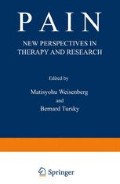Abstract
An understanding of the mechanisms underlying spontaneous painfulness in pheripheral neuropathy of man might provide an insight into mechanisms of pain in general. Pain in peripheral neuropathy is of several kinds. Spontaneous momentary sharp jabs of pain is one kind. A more prolonged and often phasic aching, burning, stinging discomfort is a second. Both types of pain may occur together. Pain may be described as superficial in the skin or deep or as both superficial and deep. It is generally appreciated by neurologists that pain in peripheral neuropathy is often associated with a decrease of cutaneous sensation, i.e. elevation of threshold of sensation. It has not been established whether pain is associated with a selective decrease or loss of one modality of sensation as compared to another, e.g. pain vs. touch-pressure sensation. When the raised threshold is exceeded, an external stimulus may result in a painful sensation which is excessive, of long duration and involving a greater territory than in healthy persons. Our own studies have shown that patients with selective and severe impairment of mechano-receptor function without impairment of pain sensation, as occurs for example in early Friedreich’s Ataxia, had a decrease in amplitude only of the alpha potential and markedly decreased numbers especially of large diameter fibers of cutaneous nerves. Neuropathic pain was not a feature of this group of patients. Conversely, patients with relatively selective impairment of pain sensation, of thermal discrimination and of autonomic function, as occurs, for example in some cases of dominantly inherited amyloidosis and dominantly inherited sensory neuropathy, had a selective decrease in amplitude or absence of the Aδ and C potentials and on histologic evaluation had a marked decrease or absence of small myelinated and unmyelinated fibers. Not uncommonly pain was present in this group of patients.
Access this chapter
Tax calculation will be finalised at checkout
Purchases are for personal use only
Preview
Unable to display preview. Download preview PDF.
References
Ohnishi, Akio and Dyck, Peter James: Loss of Small Peripheral Sensory Neurons in Fabry Disease: histologic and morphometric evaluation of cutaneous nerves, spinal ganglia and posterior columns. Arch. Neurol. 31:120–127, Aug. 1974.
Author information
Authors and Affiliations
Editor information
Editors and Affiliations
Rights and permissions
Copyright information
© 1976 Plenum Press, New York
About this chapter
Cite this chapter
Dyck, P.J., Lambert, E.H., O’Brien, P. (1976). Pain in Peripheral Neuropathy Related to Size and Rate of Fiber Degeneration. In: Weisenberg, M., Tursky, B. (eds) Pain. Springer, Boston, MA. https://doi.org/10.1007/978-1-4684-2304-4_12
Download citation
DOI: https://doi.org/10.1007/978-1-4684-2304-4_12
Publisher Name: Springer, Boston, MA
Print ISBN: 978-1-4684-2306-8
Online ISBN: 978-1-4684-2304-4
eBook Packages: Springer Book Archive

